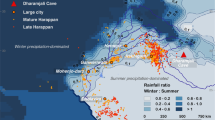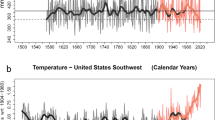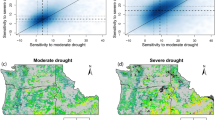Abstract
STUDIES from sites around the world1–5 have provided evidence for anomalous climate conditions persisting for several hundred years before about AD 1300. Early workers emphasized the temperature increase that marked this period in the British Isles, coining the terms 'Mediaeval Warm Epoch' and 'Little Climatic Optimum', but many sites seem to have experienced equally important hydrological changes. Here I present a study of relict tree stumps rooted in present-day lakes, marshes and streams, which suggests that California's Sierra Nevada experienced extremely severe drought conditions for more than two centuries before ad ∼ 1112 and for more than 140 years before ad ∼ 1350. During these periods, runoff from the Sierra was significantly lower than during any of the persistent droughts that have occurred in the region over the past 140 years. I also present similar evidence from Patagonia of drought conditions coinciding with at least the first of these dry periods in California. I suggest that the droughts may have been caused by reorientation of the mid-latitude storm tracks, owing to a general contraction of the circumpolar vortices and/or a change in the position of the vortex waves. If this reorientation was caused by mediaeval warming, future natural or anthropogenically induced warming may cause a recurrence of the extreme drought conditions.
This is a preview of subscription content, access via your institution
Access options
Subscribe to this journal
Receive 51 print issues and online access
$199.00 per year
only $3.90 per issue
Buy this article
- Purchase on Springer Link
- Instant access to full article PDF
Prices may be subject to local taxes which are calculated during checkout
Similar content being viewed by others
References
Lamb, H. H. Climate: Past, Present, and Future (Methuen, London, 1977).
Baerrels, D. A. & Bryson, R. A. (eds). Archs Archeol. 29, 1–673 (1967).
Bryson, R. A. & Swain, A. M. Quat. Res. 16, 135–145 (1981).
Vance, R. E., Mathewes, R. W. & Clague, J. J. Geology 20, 879–882 (1992).
Cook, E. et al. Science 253, 1266–1268 (1991).
Stine, S. Envir. Geol. Water Sci. 17, 67–83 (1990).
Stine, S. Palaeogeogr. Palaeoclimatol. Palaeoecol. 78, 333–381 (1990).
Stine, S. thesis, Univ. California (1987).
Stine, S. & Stine, M. Nature 345, 705–708 (1990).
Bryson, R. A. & Padoch, C. Climate and History (eds Rotberg, R. I. & Rabb, T. K.) 3–18 (Princeton Univ. Press, 1981).
Stuiver, M. & Reimer, P. Radiocarbon 35, 215–230 (1993).
Lawrence, D. B. & Lawrence, E. G. Ann. N. Y. Acad. Sci. 95, 341 (1961).
Author information
Authors and Affiliations
Rights and permissions
About this article
Cite this article
Stine, S. Extreme and persistent drought in California and Patagonia during mediaeval time. Nature 369, 546–549 (1994). https://doi.org/10.1038/369546a0
Received:
Accepted:
Issue Date:
DOI: https://doi.org/10.1038/369546a0
This article is cited by
-
Tropical decadal variability in nutrient supply and phytoplankton community in the Central Equatorial Pacific during the late Holocene
Scientific Reports (2024)
-
The response of the hydrological cycle to temperature changes in recent and distant climatic history
Progress in Earth and Planetary Science (2022)
-
Megadroughts in the Common Era and the Anthropocene
Nature Reviews Earth & Environment (2022)
-
ENSO-driven coupled megadroughts in North and South America over the last millennium
Nature Geoscience (2021)
-
A low-to-no snow future and its impacts on water resources in the western United States
Nature Reviews Earth & Environment (2021)
Comments
By submitting a comment you agree to abide by our Terms and Community Guidelines. If you find something abusive or that does not comply with our terms or guidelines please flag it as inappropriate.



